The great accelerator
Climate change is considered one of the most critical global issues of our time. It has been an accelerant for mass environmental and ecological awareness and triggered unprecedented levels of investment into renewable energy and carbon-reducing infrastructure from governments and businesses worldwide.
Meeting carbon-neutral targets within the next 30 years will require the use of different types of cost-effective renewable energy and energy storage. Generally, new technologies of any kind start off expensive, with prices reducing with economies of scale.
Early renewable energy products like wind turbines, solar panels, and lithium-ion batteries have significantly reduced their cost over time and now are the cheapest form of energy in Australia (CSIRO Media Release, Renewables still the cheapest new-build power in Australia, 11 December 2020) and in many other countries. As can be seen from the graph below, solar and lithium prices have reduced by 80% to 90% over the last ten years and wind is down by 65%.

The growing acceptance of climate change and the increasing demand for clean energy will only further accelerate cost efficiencies and spurn technology advancements in this sector. At the same time, public pressure is also forcing many institutional investors and asset managers around the world to diversify away from fossil fuels.
While solar, hydro and wind dominate renewable energy supplies globally, new clean energy technologies are being developed to help curb carbon emissions.
Tidal Power
Tidal power uses generators in the ocean or seas to harvest energy from regular changes in the tides.
Carbon Scrubbers
A carbon dioxide scrubber is equipment that absorbs carbon dioxide (CO2). It is used to treat exhaust gases from industrial plants or from exhaled air in life support systems. They have also been researched for carbon capture and storage as a means of combating global warming.
Heat Pumps
A heat pump is energy-saving technology that conveys heat without the need to generate heat. For example, the transfer of heat from outdoors to inside a room using only a little electricity.
All of the above new technologies are currently relatively expensive. Tidal power is estimated to cost US$130 to $280 per Mwh compared to wind and solar electricity which are US$26 and US$29 per Mwh. But, just as the cost of solar, wind and lithium batteries has decreased over time, we expect the cost of these new technologies will fall, too, as they gain economic scale and provide additional alternatives to meet climate and carbon targets.
Existing renewable clean technologies are growing rapidly and will be joined by many more technologies on our journey to carbon neutrality.
4 topics

